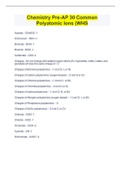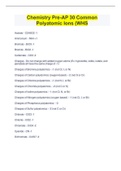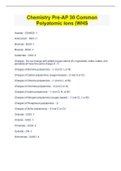Iodate Study guides, Class notes & Summaries
Looking for the best study guides, study notes and summaries about Iodate? On this page you'll find 34 study documents about Iodate.
Page 3 out of 34 results
Sort by

-
SOLVED PROBLEMS FOR OCR A-LEVEL CHEMISTRY PAPER 3
- Exam (elaborations) • 10 pages • 2024
-
- $6.39
- + learn more
What is oxidation and what is reduction? - CORRECT ANSWER-Oxidation Is Loss Reduction Is Gain What does the oxidising and reducing agent do? - CORRECT ANSWER-Oxidising agent accepts electrons - reduced Reducing agent donates electrons - oxidised How can you work out the concentration of a reducing agent? - CORRECT ANSWER-By titrating a known volume of it against an oxidising agent with a known concentration How can you work out the concentration of an oxidising agent? - CORRECT ANSWER-I...

-
DAT - Common Ions 100% Correct
- Exam (elaborations) • 6 pages • 2023
- Available in package deal
-
- $8.49
- + learn more
DAT - Common Ions 100% Correct NH4+ Ammonium H3O+ Hydronium Hg2 2+ Mercury (I) H2PO 3- Dihydrogen Phosphite H2PO 4- Dihydrogen Phosphate HCO 3- Hydrogen Carbonate HSO 3- Hydrogen Sulfite HSO 4- Hydrogen Sulfate NO 2- Nitrite NO 3- Nitrate OH- Hydroxide CH3COO- Acetate CrO 2- Chromite CN- Cyanide CNO- Cyanate CNS- Thiocyanate MnO4- Permanganate ClO- Hypochlorite ClO 2- Chlorite ClO 3- Chlorate ClO 4- Perchlorate BrO- Hypobromite BrO 2- Bromite BrO 3- Bromate BrO 4- Perbrom...

-
FNDH 700 Final | 100% Correct | Verified | 2024 Version
- Exam (elaborations) • 5 pages • 2024
-
- $9.83
- + learn more
FNDH 700 Final | 100% Correct | Verified | 2024 Version The only nutrient deficiency that is also prevalent in Industrialized counties - Iron Iron deficiency's effect on Transferrin - increases transferrin synthesis and total iron binding capacity Physical symptoms in severe IDA - Reduced work capacity and breathlessness on exertion What exacerbates anemia - Infectious diseases such as malaria and worm infections What interferes with iron absorption? - Phytates, this is an iss...

-
CHEM 123 - Lab final - UBC Exam With 100% Verified Answers A+ Guaranteed.
- Exam (elaborations) • 14 pages • 2024
- Available in package deal
-
- $12.99
- + learn more
why do we perform iodometric titrations - correct answer to find the concentration of an unknown by mixing it with a solution of known concentration What are the 4 (general) steps of an iodometric titration? - correct answer combine solutions, reach endpoint, calculate, determine the concentration of the unknown What reaction takes place during an iodometric titration? - correct answer oxidation-reduction reaction what is used as the oxidizing agent in an iodometric titra...

-
Chemistry Final Exam (Answered)
- Exam (elaborations) • 34 pages • 2024
-
- $13.50
- + learn more
Chemistry Final Exam (Answered) Oxidation Rules Rule 1: The oxidation number of an element in its free state = 0 (Also true for diatomic elements) -Mg=0,H2=0, C=0 Rule 2: The oxidation number of a monatomic (one-atom) ion is the same as the charge on the ion -Mg^2+=+2, Na^+=+1, O^2-=-2 Rule 3: The sum of all oxidation numbers in a neutral compound is zero. The sum of all oxidation numbers in a polyatomic (many-atom) ion is equal to the charge on the ion. Rule 4: The oxidation numb...

-
Chemistry Final Exam (Answered)
- Exam (elaborations) • 34 pages • 2024
-
- $13.99
- + learn more
Chemistry Final Exam (Answered) Oxidation Rules Rule 1: The oxidation number of an element in its free state = 0 (Also true for diatomic elements) -Mg=0,H2=0, C=0 Rule 2: The oxidation number of a monatomic (one-atom) ion is the same as the charge on the ion -Mg^2+=+2, Na^+=+1, O^2-=-2 Rule 3: The sum of all oxidation numbers in a neutral compound is zero. The sum of all oxidation numbers in a polyatomic (many-atom) ion is equal to the charge on the ion. Rule 4: The oxidation numb...

-
Chemistry Pre-AP 30 Common Polyatomic Ions (WHS
- Exam (elaborations) • 3 pages • 2023
-
- $11.49
- + learn more
Acetate - C2H3O2 -1 Ammonium - NH4 +1 Bromate - BrO3 -1 Bromite - BrO2 -1 Carbonate - CO3 -2 Charges - Do not change with added oxygen atoms (Ex: hypoiodite, iodite, iodate, and periodate all have the same charge of -1) Charges of Bromine polyatomics - -1 (not Cl, I, or N) Charges of Carbon polyatomics (oxygen-based) - -2 (not S or Cr) Charges of Chlorine polyatomics - -1 (not N, I, or Br) Charges of Chromite polyatomics - -2 (not C or S) Charges of Iodine polyatomics - -1 (not Cl, N...

-
Chemistry Pre-AP 30 Common Polyatomic Ions (WHS
- Exam (elaborations) • 3 pages • 2023
-
- $11.49
- + learn more
Acetate - C2H3O2 -1 Ammonium - NH4 +1 Bromate - BrO3 -1 Bromite - BrO2 -1 Carbonate - CO3 -2 Charges - Do not change with added oxygen atoms (Ex: hypoiodite, iodite, iodate, and periodate all have the same charge of -1) Charges of Bromine polyatomics - -1 (not Cl, I, or N) Charges of Carbon polyatomics (oxygen-based) - -2 (not S or Cr) Charges of Chlorine polyatomics - -1 (not N, I, or Br) Charges of Chromite polyatomics - -2 (not C or S) Charges of Iodine polyatomics - -1 (not Cl, N...

-
Chemistry Pre-AP 30 Common Polyatomic Ions (WHS
- Exam (elaborations) • 3 pages • 2023
-
- $10.49
- + learn more
Acetate - C2H3O2 -1 Ammonium - NH4 +1 Bromate - BrO3 -1 Bromite - BrO2 -1 Carbonate - CO3 -2 Charges - Do not change with added oxygen atoms (Ex: hypoiodite, iodite, iodate, and periodate all have the same charge of -1) Charges of Bromine polyatomics - -1 (not Cl, I, or N) Charges of Carbon polyatomics (oxygen-based) - -2 (not S or Cr) Charges of Chlorine polyatomics - -1 (not N, I, or Br) Charges of Chromite polyatomics - -2 (not C or S) Charges of Iodine polyatomics - -1 (not Cl, N...

-
Polyatomic Ions(A polyatomic ion is a charged particle which has two or more atoms held together by covalent (sharing of pairs of electrons) bonds Some rules: 1. Ions that end in ate have oxygen in them. 2. Elements in the same family make similar ions. S
- Exam (elaborations) • 3 pages • 2023
-
- $9.99
- + learn more
Polyatomic Ions(A polyatomic ion is a charged particle which has two or more atoms held together by covalent (sharing of pairs of electrons) bonds Some rules: 1. Ions that end in ate have oxygen in them. 2. Elements in the same family make similar ions. So for example if you know chlorate, you also know bromate and iodate too (BrO3-, and IO3-). There are some exceptions. Nitrate is not like phosphate even though nitrogen and phosphorus are in the same group. However arsenate is like phosphate. (...

That summary you just bought made someone very happy. Also get paid weekly? Sell your study resources on Stuvia! Discover all about earning on Stuvia


